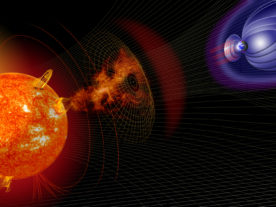
This artist’s conception shows the rocky exoplanet GJ 1132b, located 39 light-years from Earth. (Dana Berry/Skyworks Digital/CfA)
Nearby Exoplanet’s Atmosphere May Contain Oxygen
In November 2015, scientists discovered a Venus-like planet that’s only 39 light years away, called Gliese 1132b.
The planet is thought to have an atmosphere, despite having a blistering temperature of more than 230° degrees Celsius, since it orbits its red dwarf star from a distance of only 2.25 million kilometers.
A new study suggests that the exoplanet’s atmosphere is thick and dense and may contain a little bit oxygen too.
Since the planet is so relatively close to its sun, scientists say it’s being bombarded with ultraviolet light.
This UV light can break down water molecules, separating them into hydrogen and oxygen. Since hydrogen is so light, it can easily escape into space, leaving some of the oxygen to stay behind.
Study authors say they think the planet has a strong greenhouse effect, which can increase its already hot temperature. Because of this, it’s thought that the planet’s surface, which is molten, will remain so for millions of years.

A simulated view of the entire observable universe, approximately 93 billion light years or 28 billion parsecs in diameter. (Azcolvin429 via Creative Commons)
Observable Universe Might Be Smaller Than Thought
Did you ever wonder – how big is the universe?
In 2005, scientists, using data from NASA’s Wilkinson Microwave Anisotropy Probe (WMAP), calculated the radius of the observable universe, with Earth as its center, to be 45.66 billion light years in length.
Since then, this calculation has been considered to be the standard throughout the astrophysics community.
But now, according to a blog piece written by Nick Tomasello on the website medium.com, he and Paul Halpern of the University of the Sciences have made some new calculations.
With data gathered by the European Space Agency’s Planck Satellite, they find the radius is actually a bit smaller, at 45.34 billion light years.
That’s not the entire universe, it’s the observable universe, based on the farthest light to reach Earth, which is 13.8 billion light years away.
And in all the time it took that light to reach us, the universe kept right on expanding, to its present calculated radius of 45.34 billion light years.
Learn How to “Drive” a Spacecraft
The European Space Agency is offering a special four-day course to university students that will provide a unique overview of spacecraft operations.
Called the Ladybird Guide to Spacecraft Operations, this ESA course will be taught without a lot of advanced mathematics or technical jargon.
To apply, you must meet several qualifications, such as being a citizen of a European Space Agency Member or Cooperating State.
They recommend applicants have a good grasp on basic physics and can quickly develop an understanding of the various aspects of spaceflight operations.
The European space agency says the course will be held at its Training and Learning Academy in Belgium from October 11 through 14, 2016.
Application forms can be found at the ESA website at www.esa.int and must be submitted by September 4, 2016.
A Little Bit of Your Suntan Comes from Intergalactic Space
One of the most popular things to do in the summer is to lay on the beach or in your backyard, on a sunny day, to soak up sun-rays to get a suntan.
Scientists figure that as you lie in the sun, you’re being blasted by nearly one-sextillion photons per second. That’s a one followed by 21 zeroes.
A new Australian study finds that while most of it comes from our own sun, a tiny portion of the suntan producing energy actually comes from outside the Milky Way, traveling for billions of years before finally hitting Earth.
The study suggests that we are constantly bombarded by about 10 billion photons per second from beyond our galaxy when we’re outside both day and night.
Scientists call this energy extragalactic background light. They say it’s produced from within the cores of stars in distant galaxies or from supermassive black holes.
The study also points out that intergalactic dust downgrades this energy into a wavelength that isn’t really harmful to humans.
Scientists Debunk So-Called “Chemtrail” Conspiracy Theory
76 of 77 top atmospheric scientists have debunked the so-called chemtrail conspiracy theory says a new survey.
In the late 1990s, an internet rumor developed that suggested dangerous chemicals or bio-agents were being mixed into the condensation trails, or contrails of jet aircraft.
Contrails, which look like white cloud-like streaks in the sky, are actually a bands of condensed water produced by aircraft or rockets at high altitude.
According to a 2011 international survey nearly 17 percent of respondents believed the existence of a secret large-scale atmospheric spraying program to be true.
Believers of the theory suggest that any contrail that doesn’t disperse after a few seconds or minutes must contain harmful chemical elements.
But scientists say condensation trails can last from a couple of seconds to even hours, depending on weather conditions.


























Comments are closed.